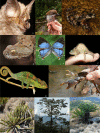A biogeographical appraisal of the threatened South East Africa Montane Archipelago ecoregion
- PMID: 38472297
- PMCID: PMC10933300
- DOI: 10.1038/s41598-024-54671-z
A biogeographical appraisal of the threatened South East Africa Montane Archipelago ecoregion
Abstract
Recent biological surveys of ancient inselbergs in southern Malawi and northern Mozambique have led to the discovery and description of many species new to science, and overlapping centres of endemism across multiple taxa. Combining these endemic taxa with data on geology and climate, we propose the 'South East Africa Montane Archipelago' (SEAMA) as a distinct ecoregion of global biological importance. The ecoregion encompasses 30 granitic inselbergs reaching > 1000 m above sea level, hosting the largest (Mt Mabu) and smallest (Mt Lico) mid-elevation rainforests in southern Africa, as well as biologically unique montane grasslands. Endemic taxa include 127 plants, 45 vertebrates (amphibians, reptiles, birds, mammals) and 45 invertebrate species (butterflies, freshwater crabs), and two endemic genera of plants and reptiles. Existing dated phylogenies of endemic animal lineages suggests this endemism arose from divergence events coinciding with repeated isolation of these mountains from the pan-African forests, together with the mountains' great age and relative climatic stability. Since 2000, the SEAMA has lost 18% of its primary humid forest cover (up to 43% in some sites)-one of the highest deforestation rates in Africa. Urgently rectifying this situation, while addressing the resource needs of local communities, is a global priority for biodiversity conservation.
© 2024. The Author(s).
Conflict of interest statement
The authors declare no competing interests.
Figures





References
-
- Lovett JC, Wasser SK. Biogeography and Ecology of the Rain Forest of Eastern Africa. Cambridge University Press; 1993.
-
- White F. The Vegetation of Africa. UNESCO; 1983.
MeSH terms
Grants and funding
LinkOut - more resources
Full Text Sources

